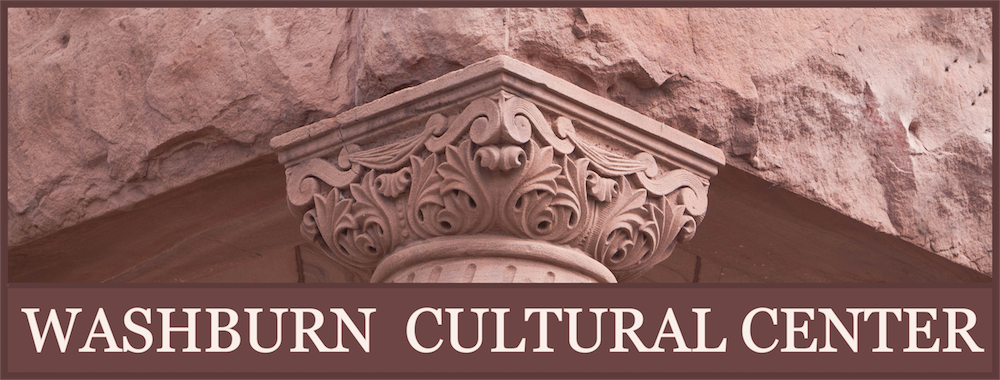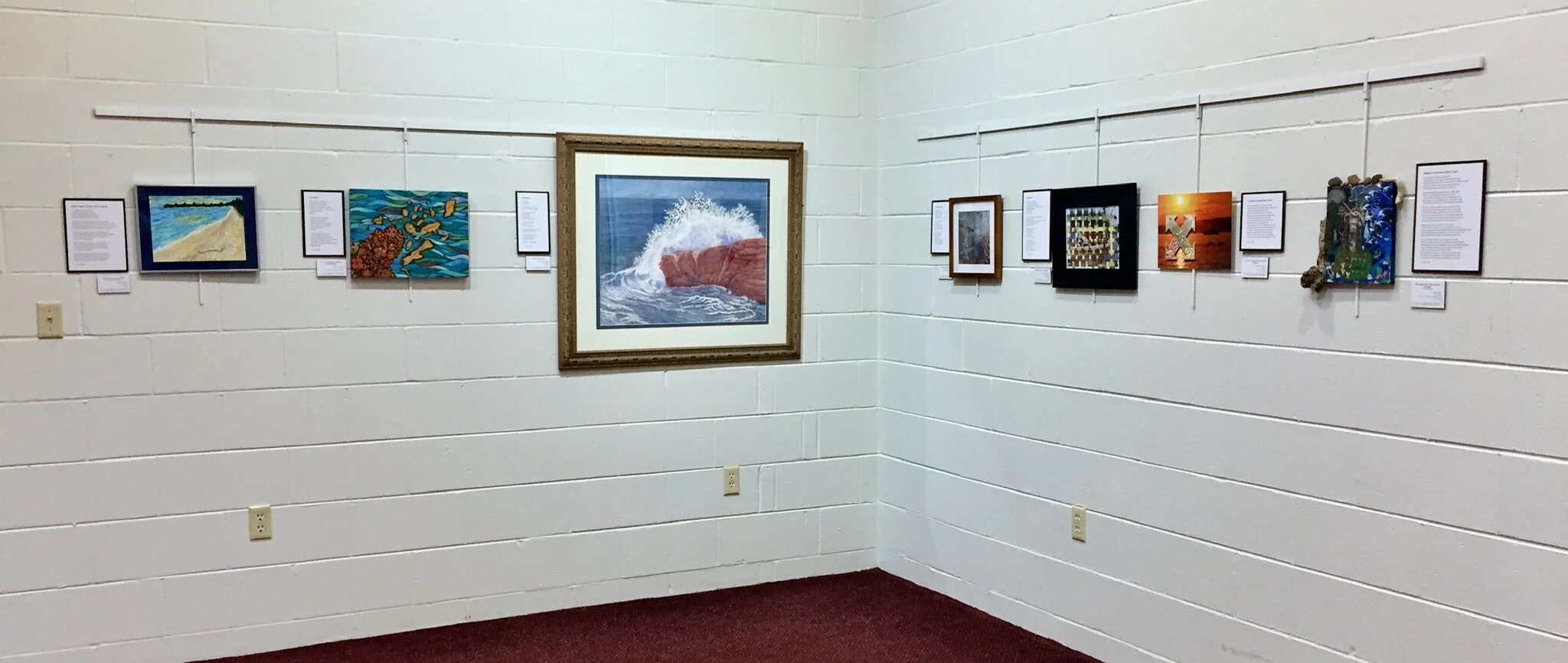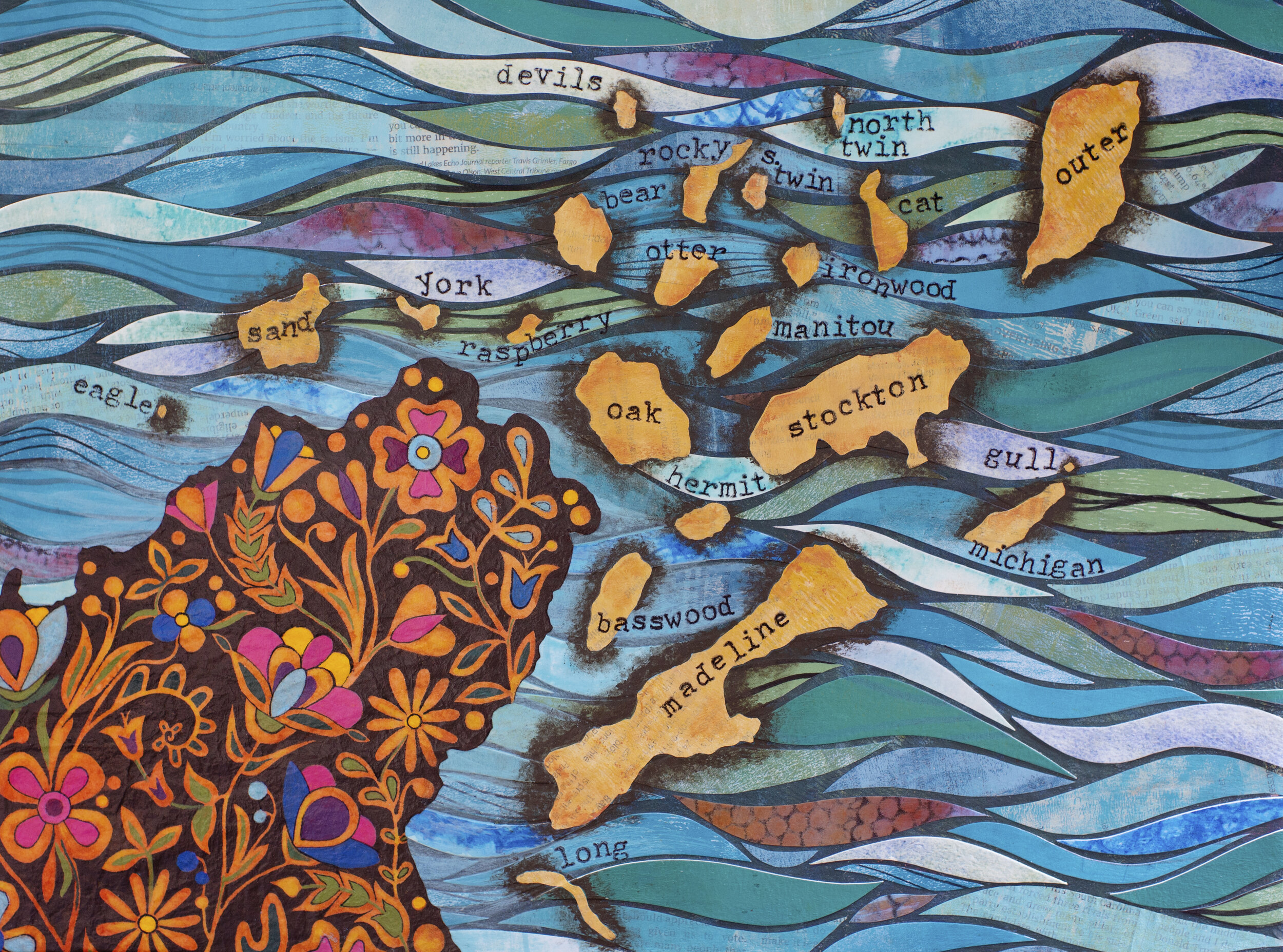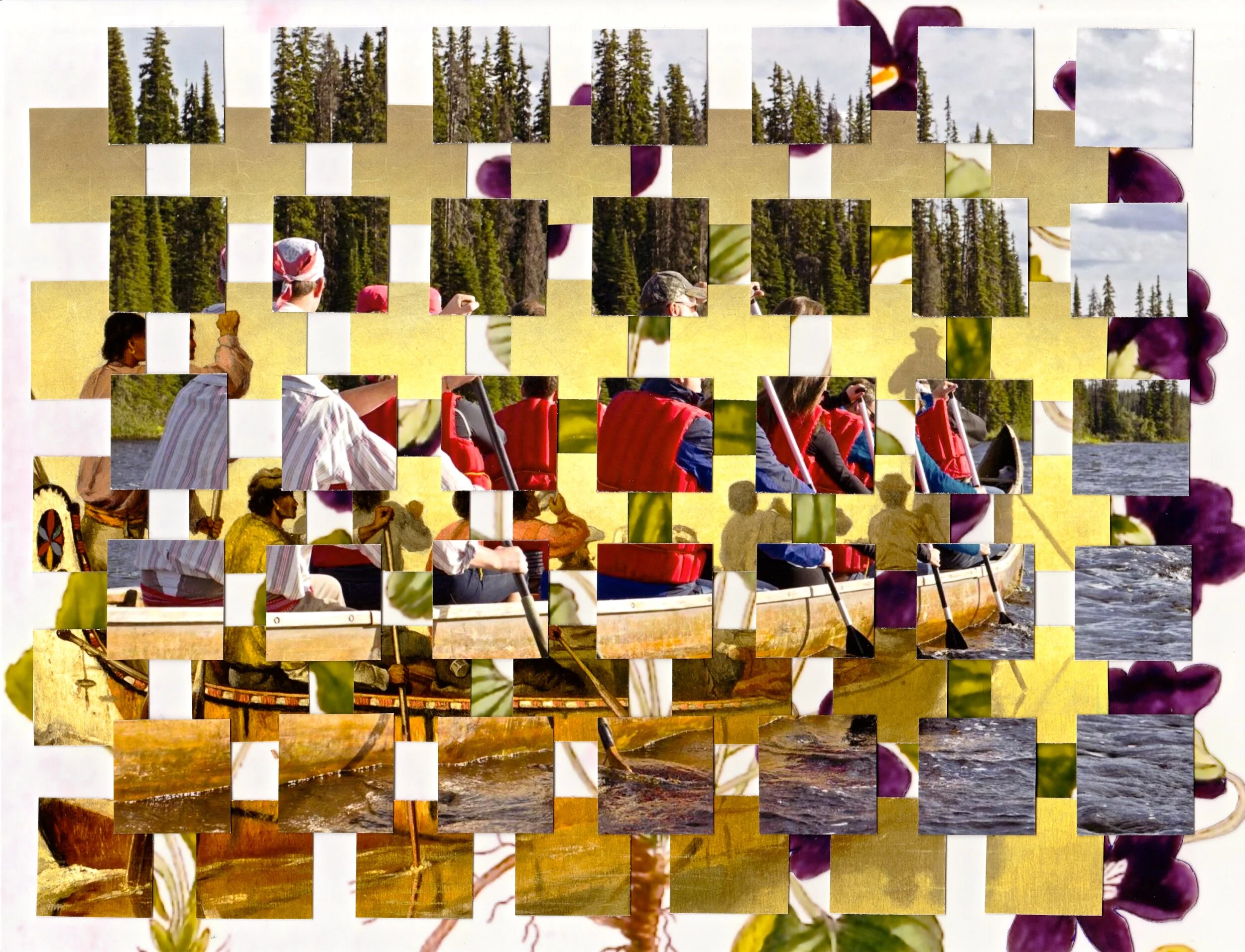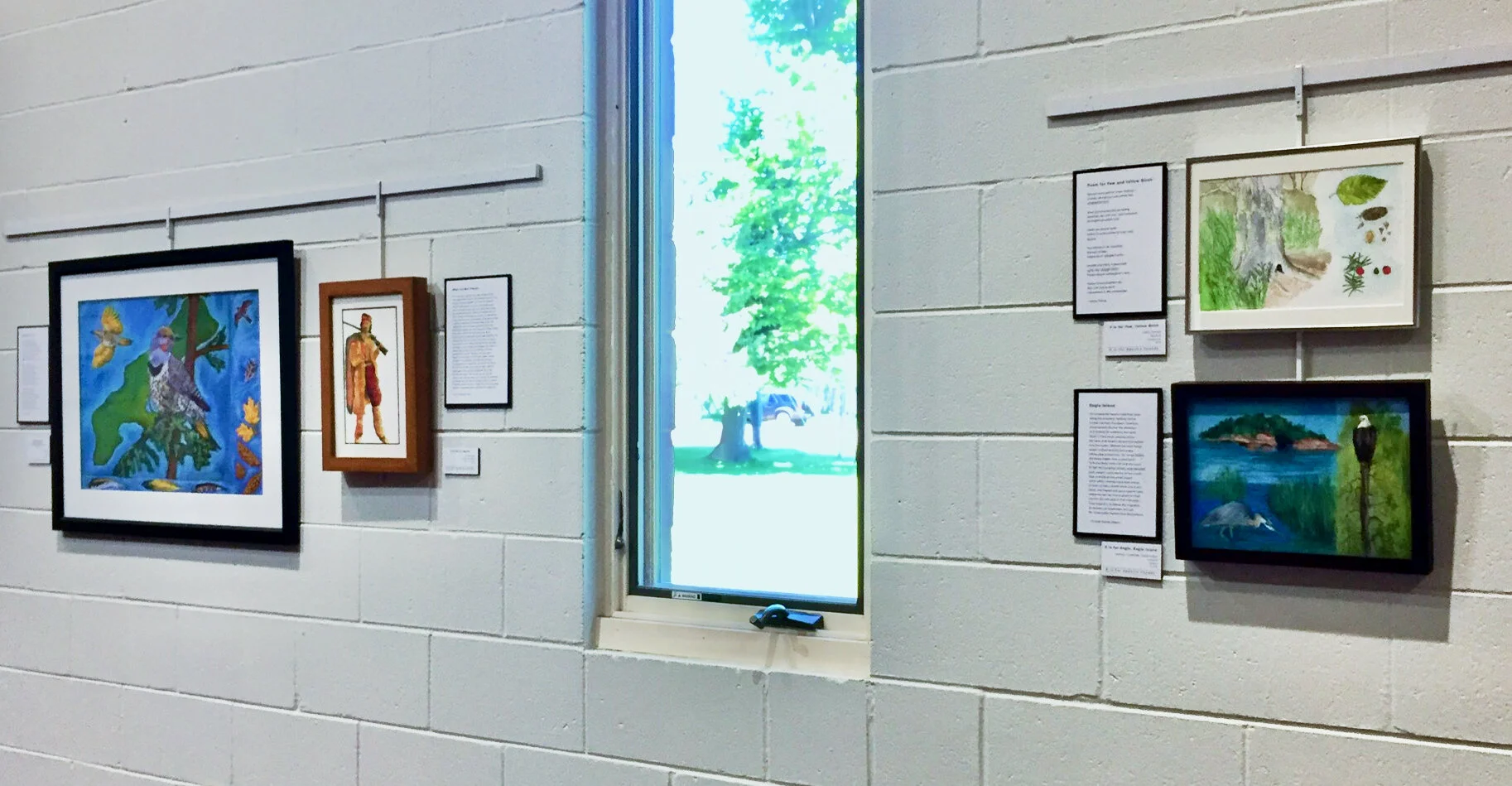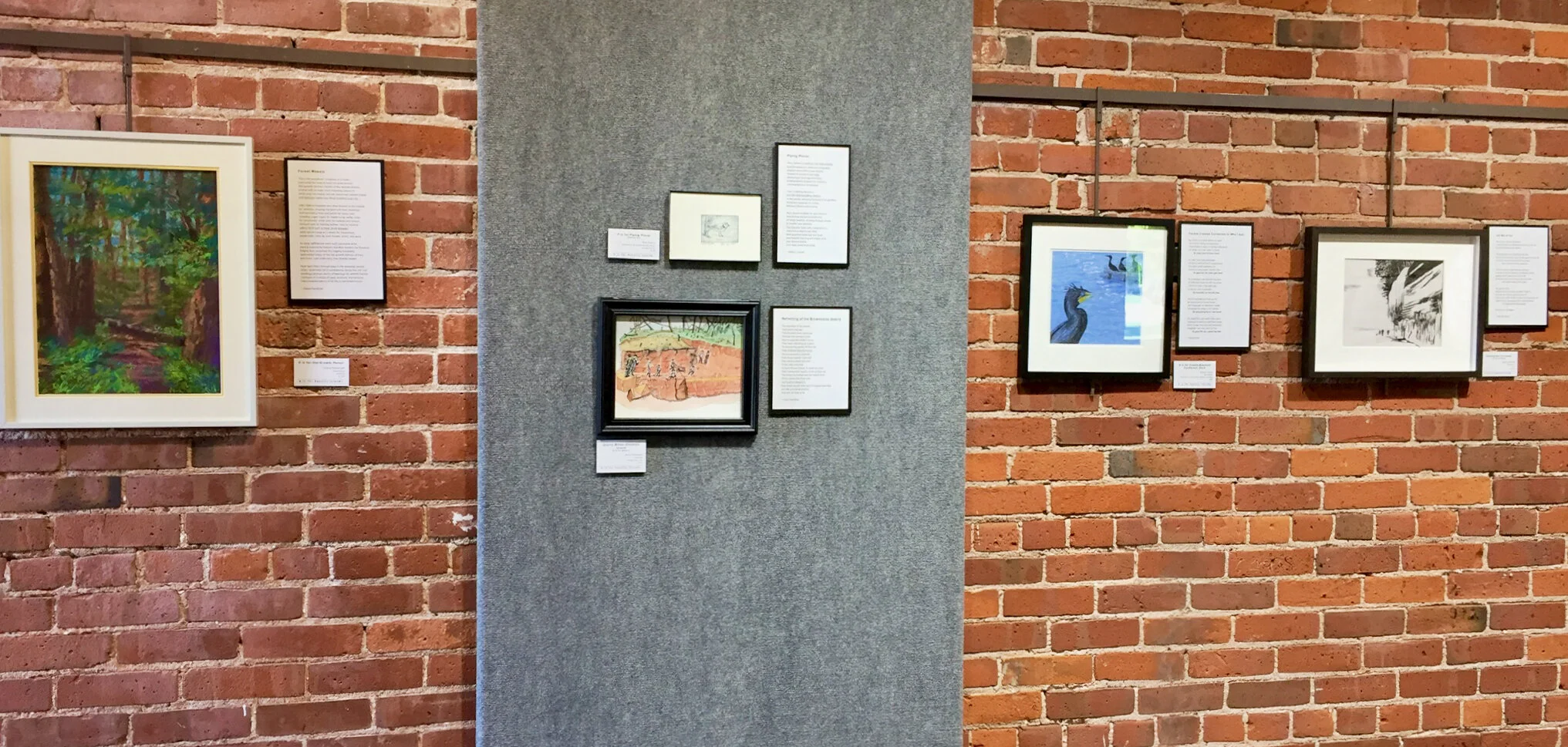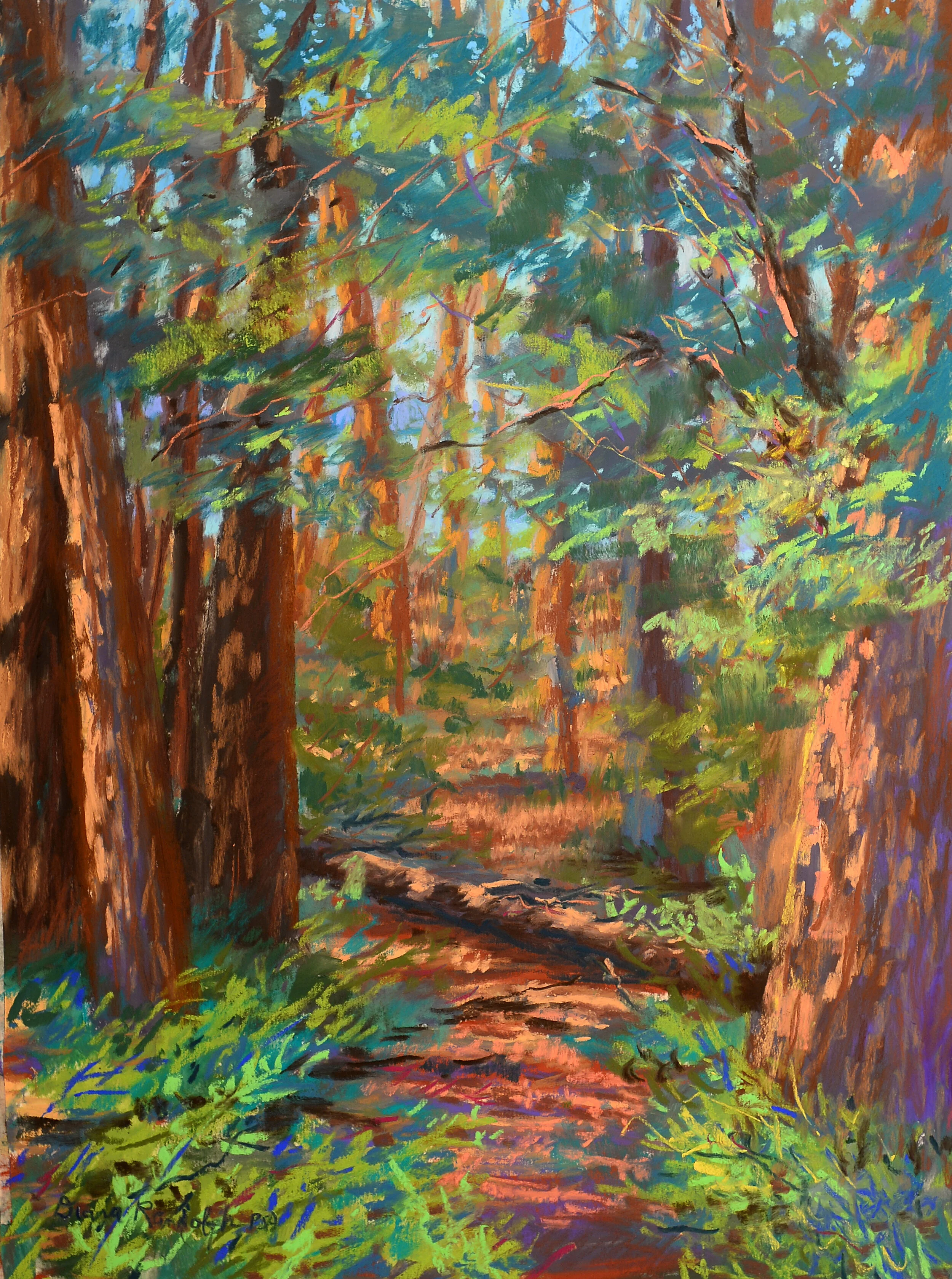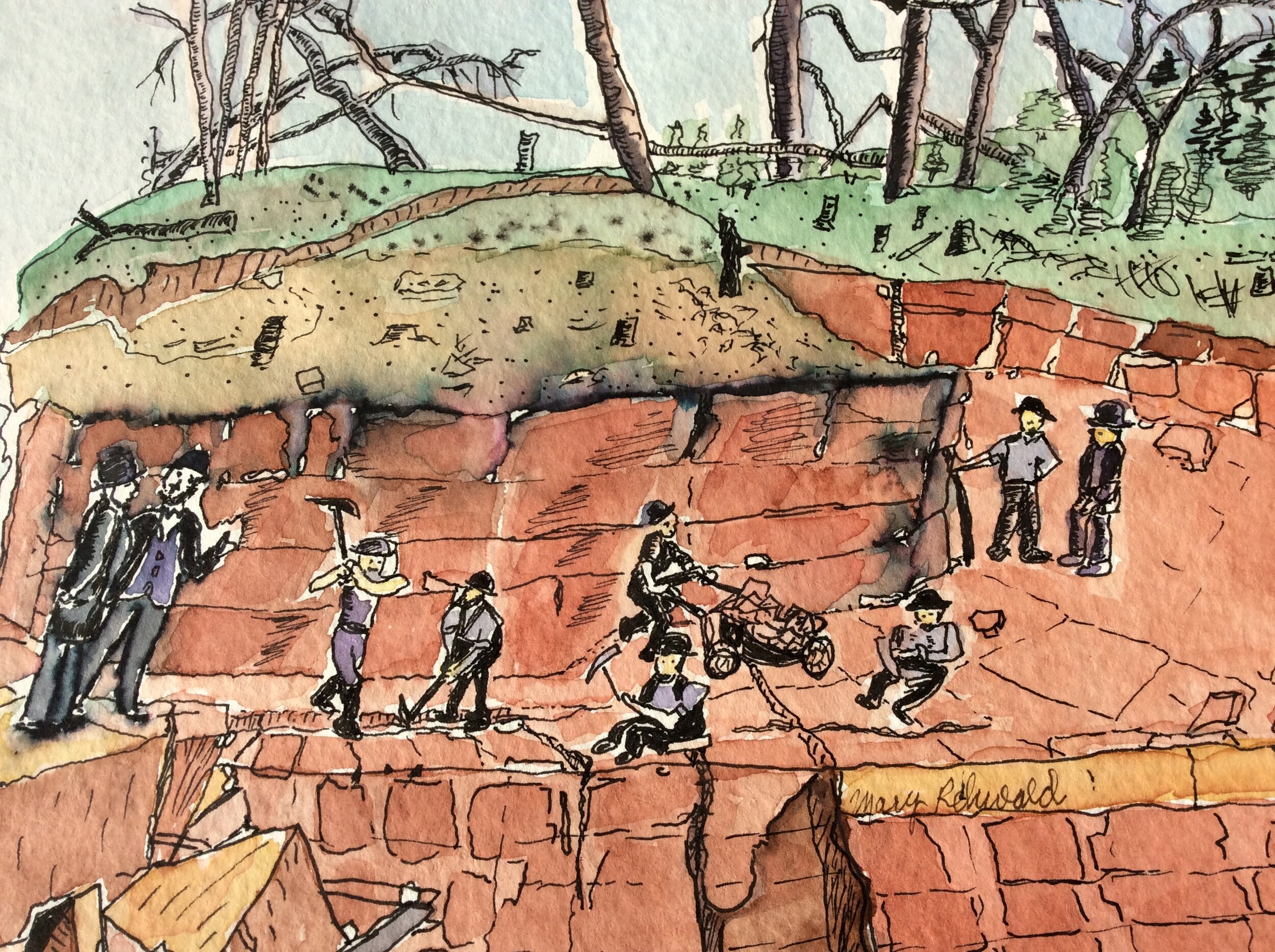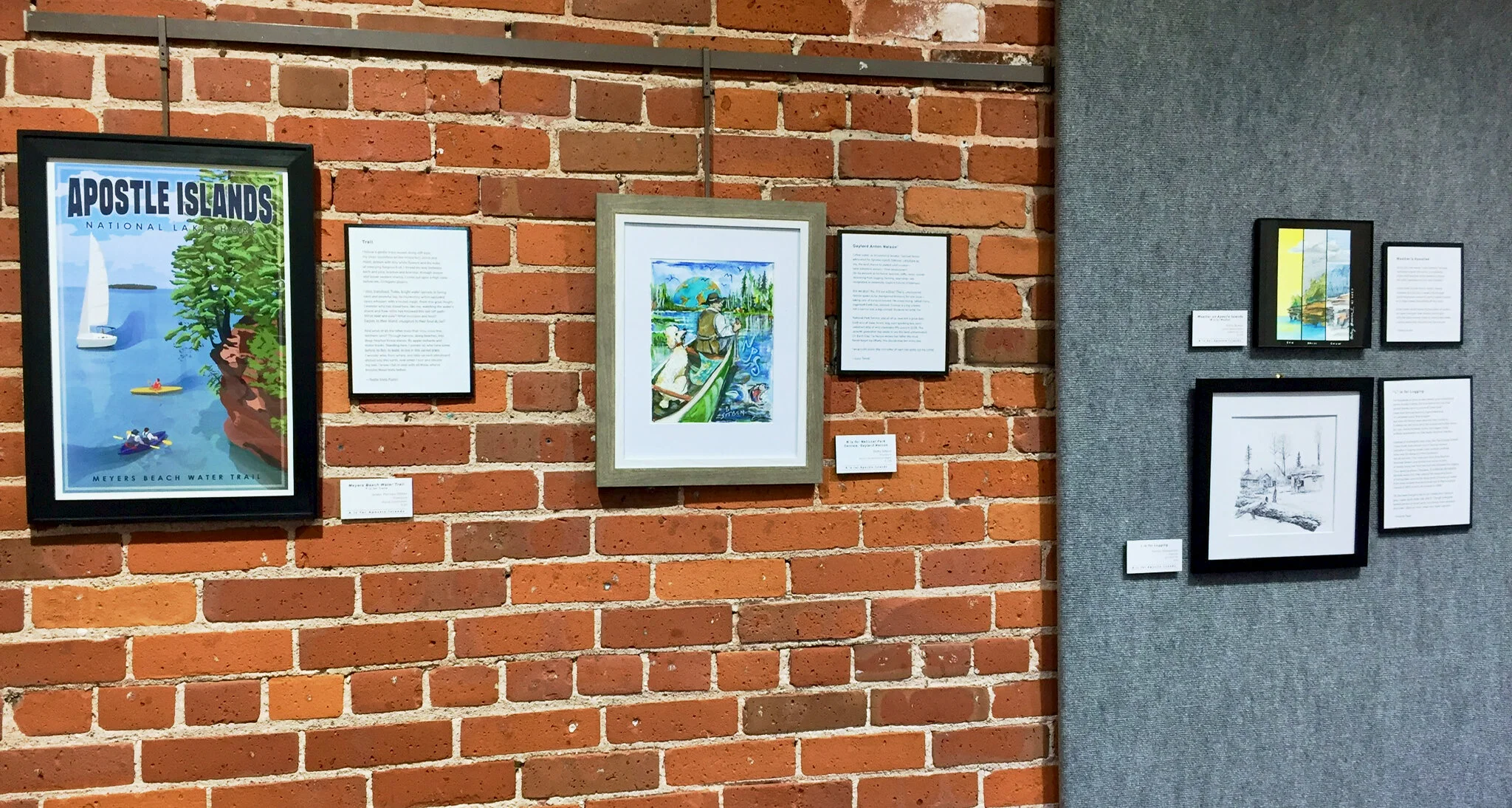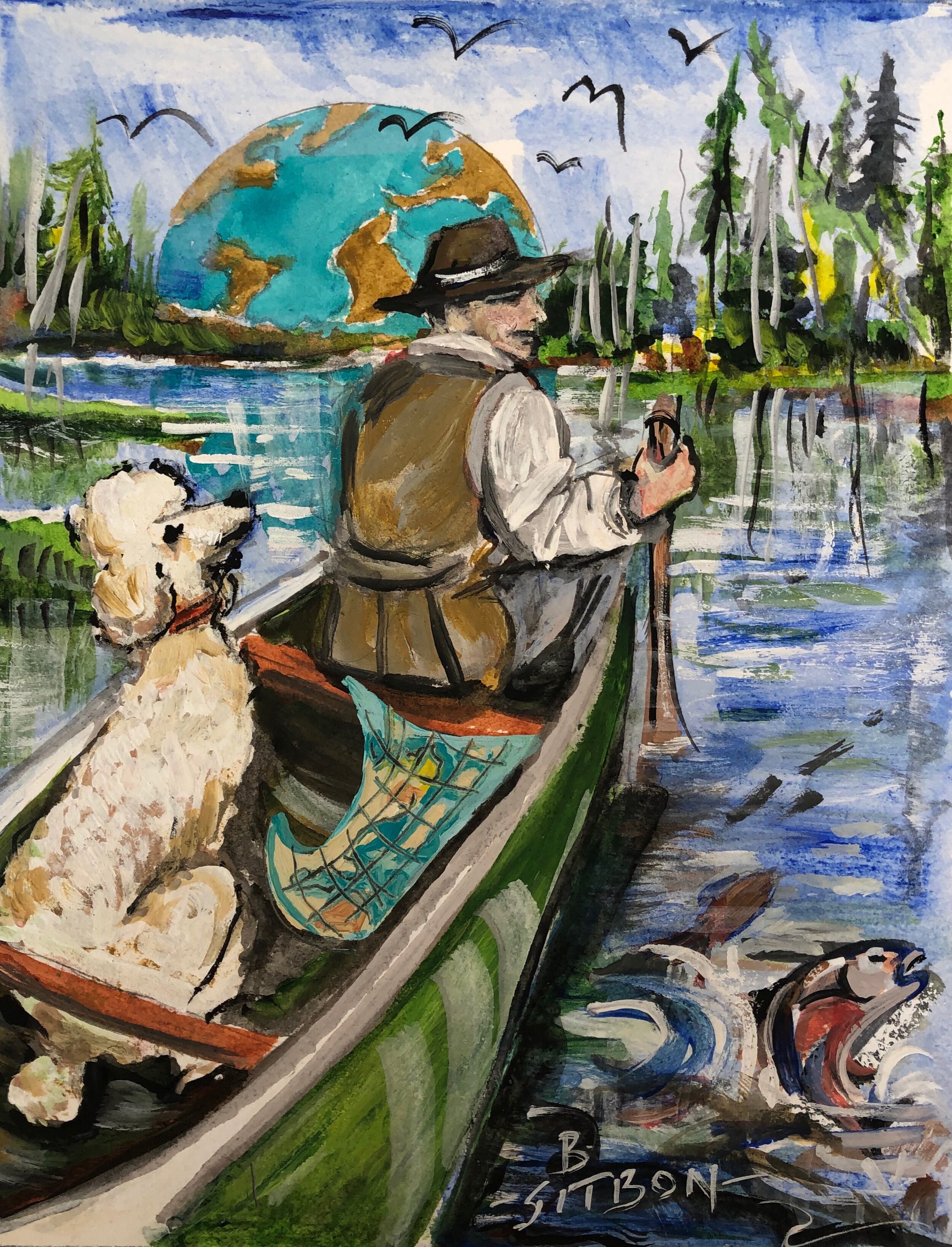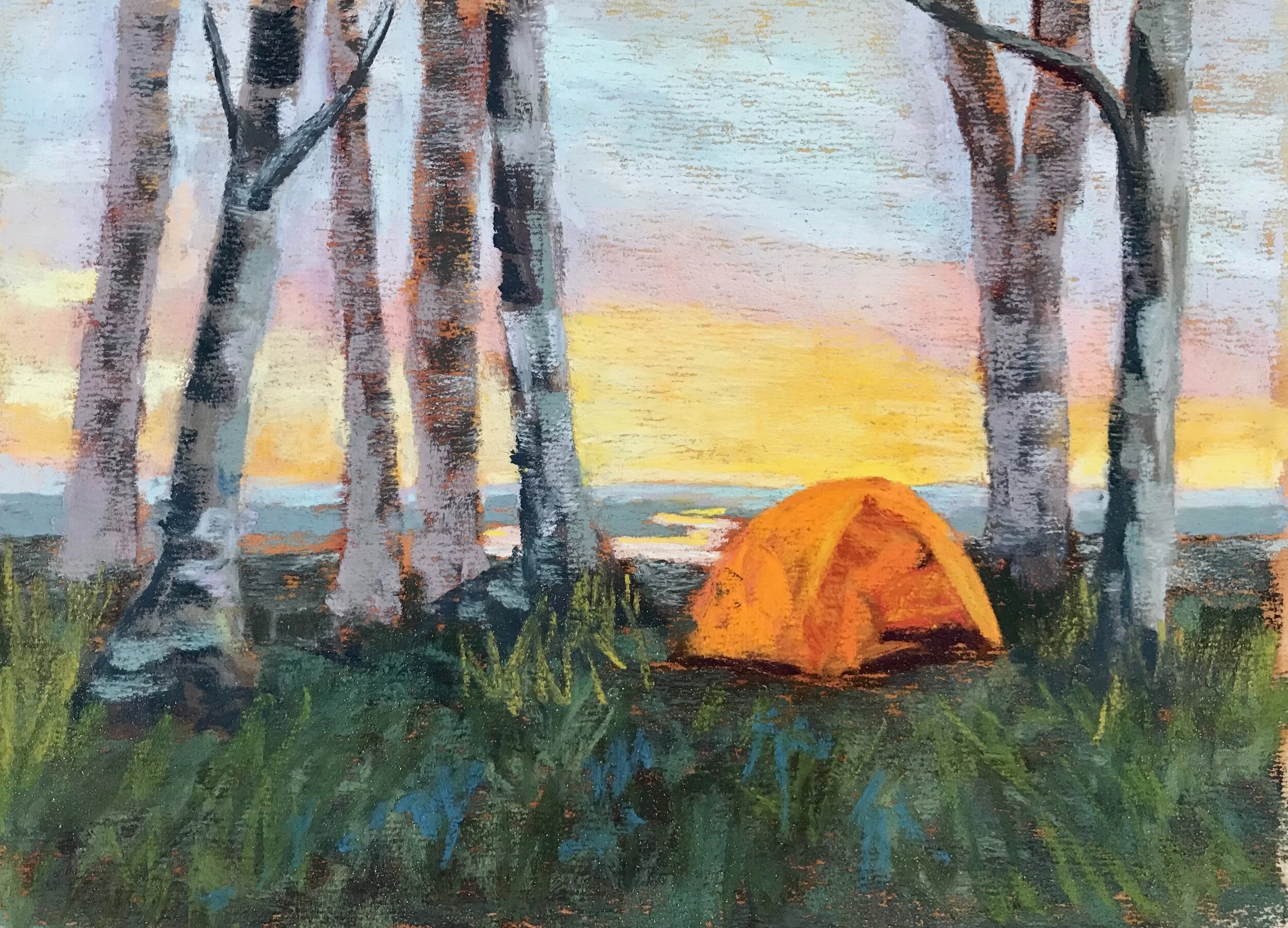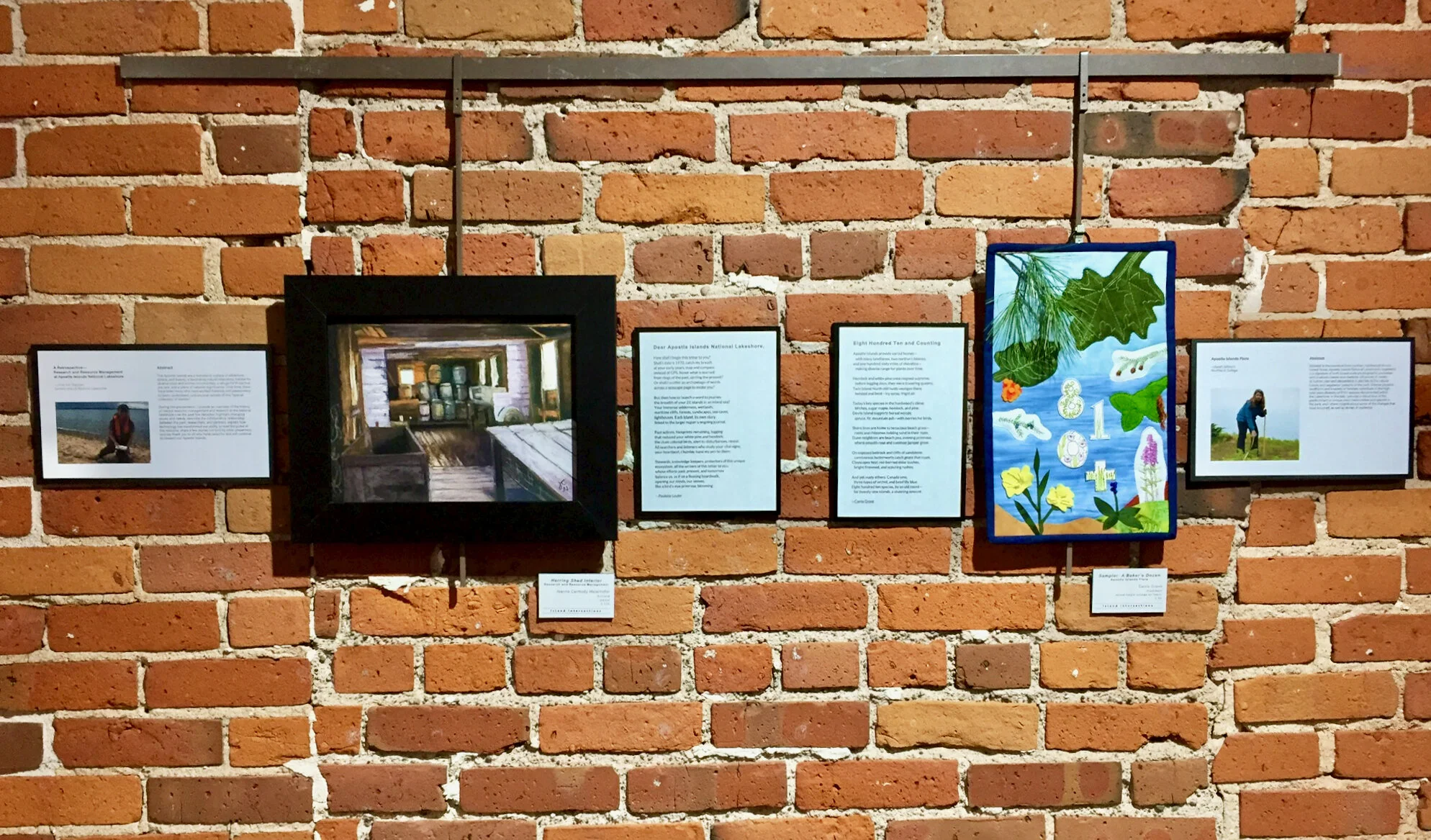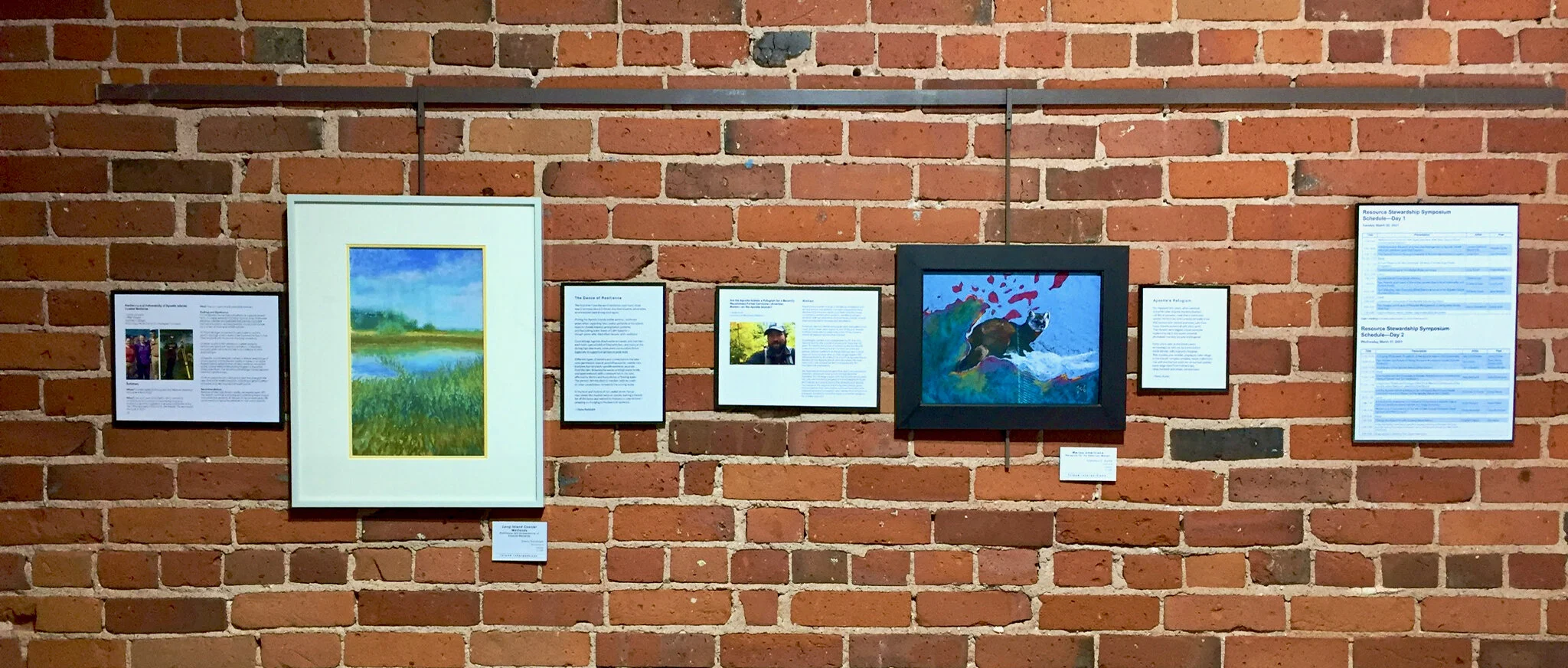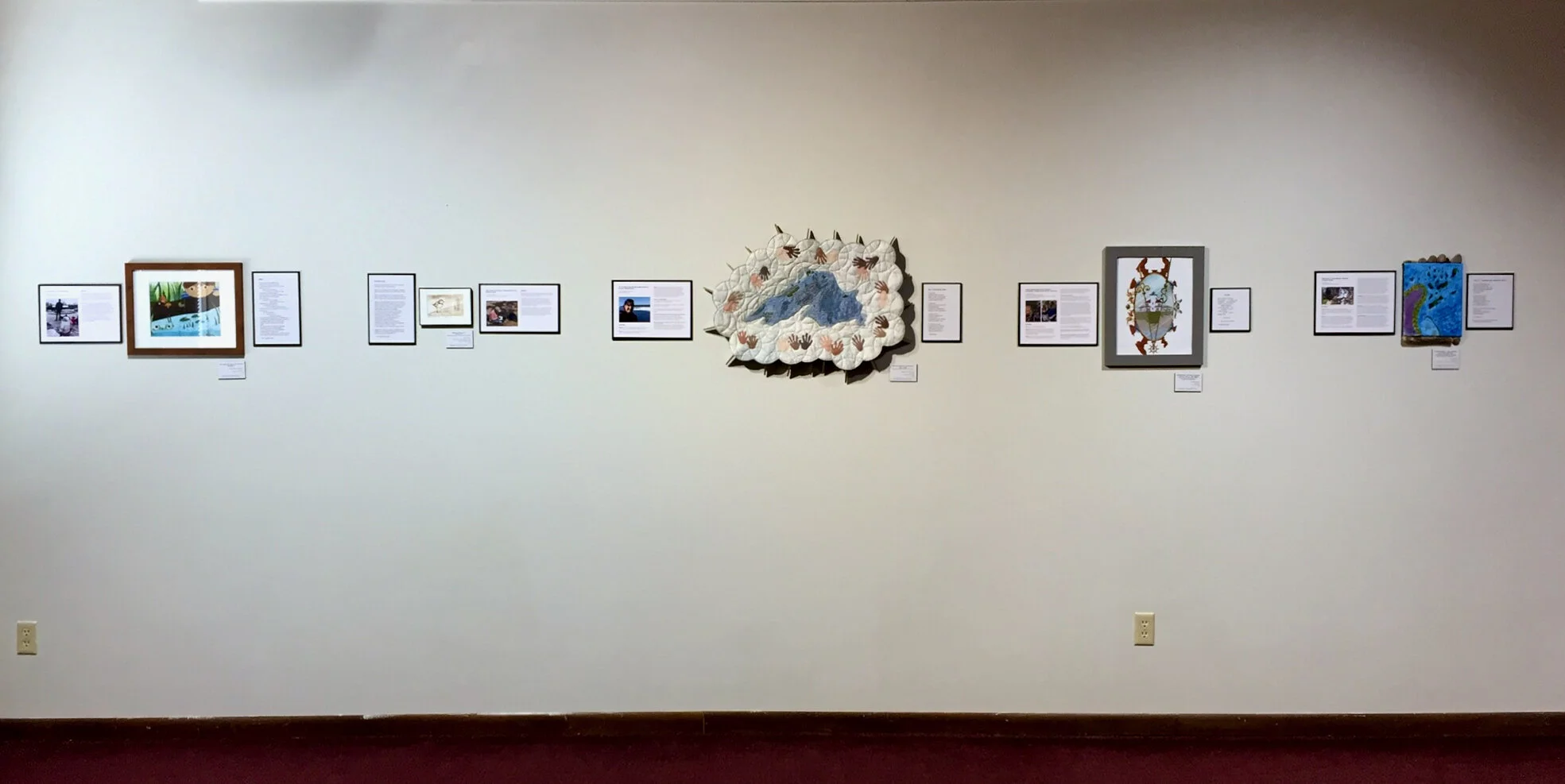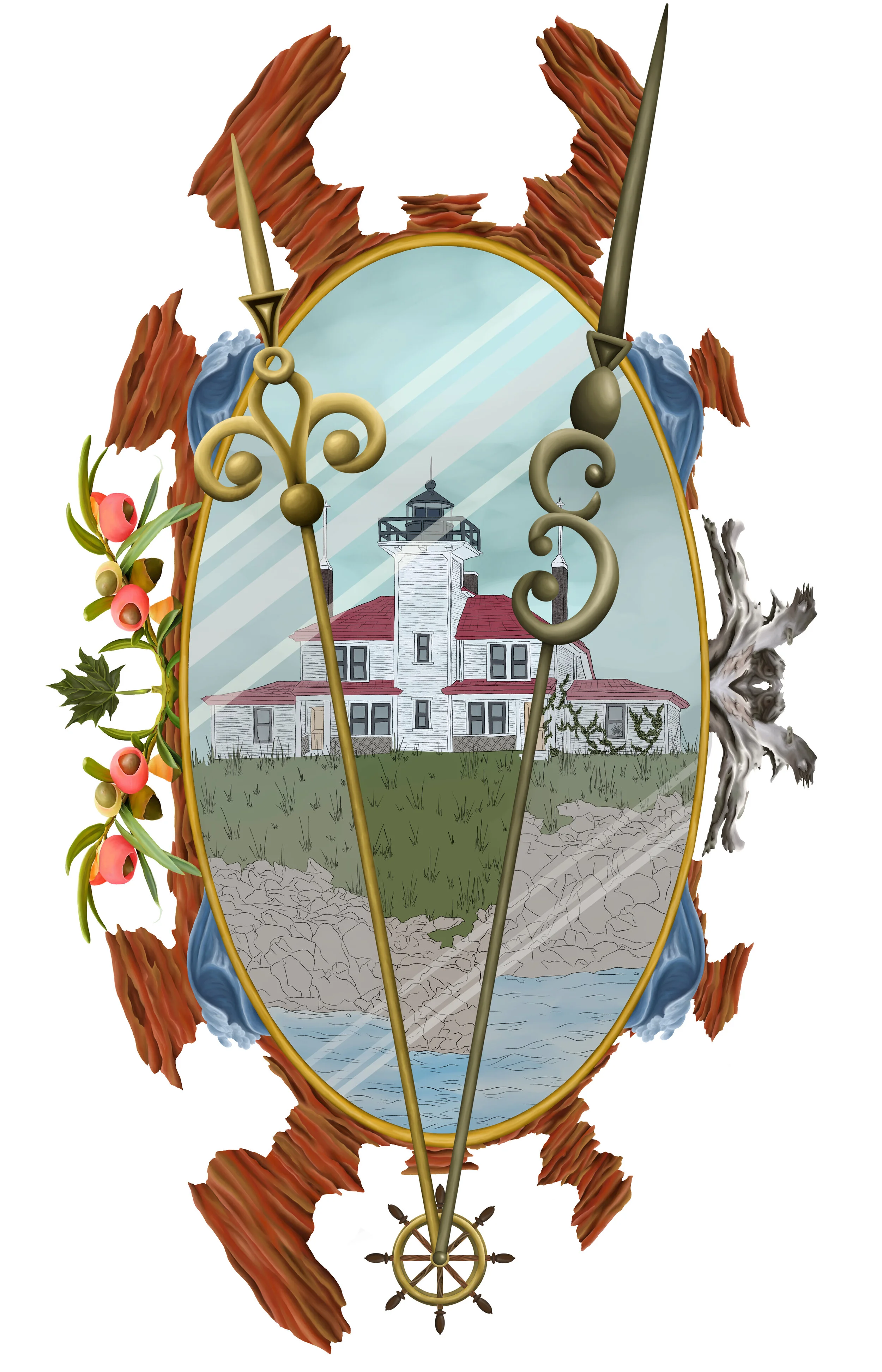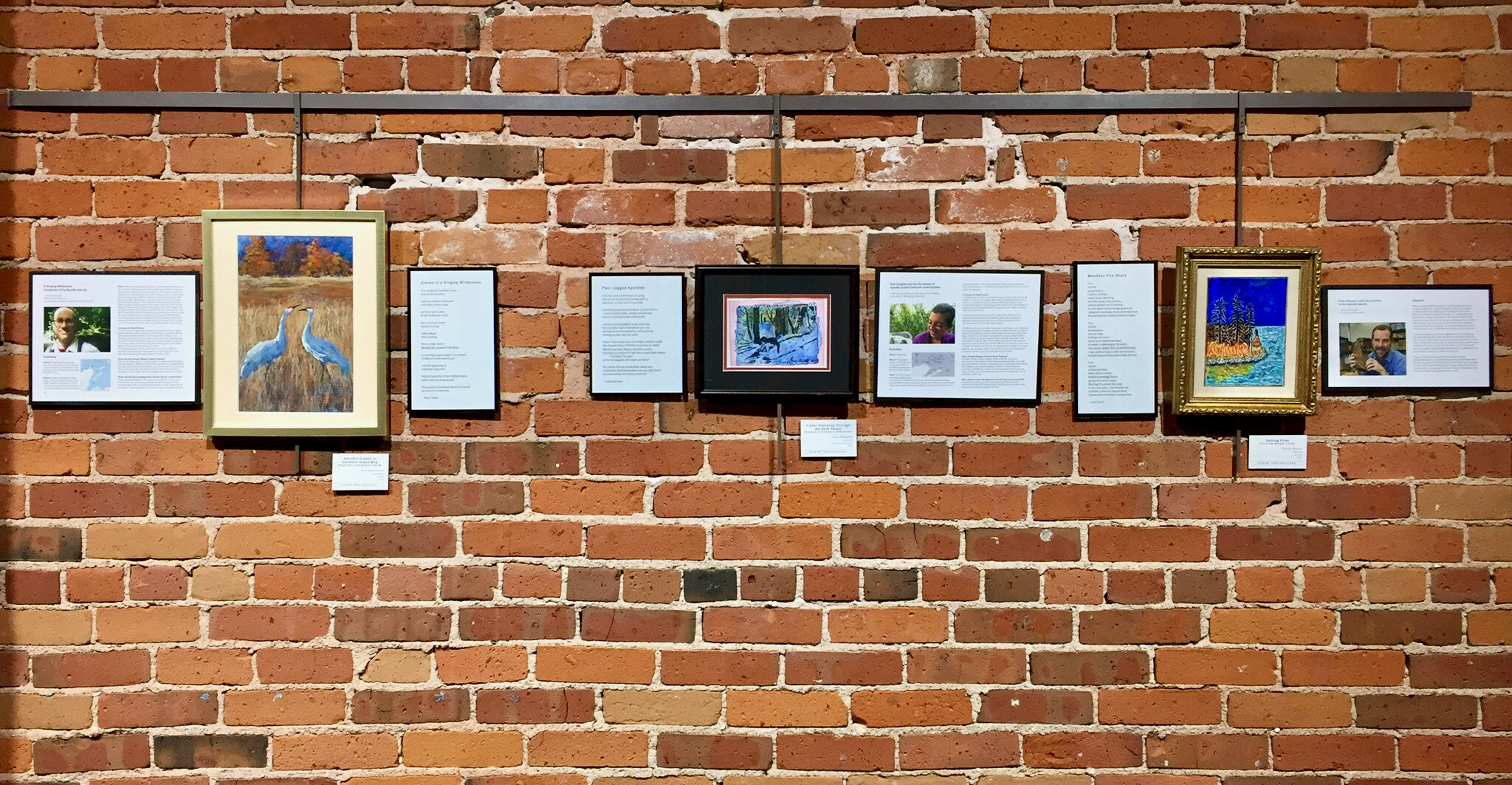A is for APOSTLE ISLANDS & ISLAND INTERSECTIONS
ORGANIZED BY LUCY TYRRELL
JUNE 2—30, 2021
This exhibit displays the poetry and visual artwork from two projects celebrating the 50th anniversary of Apostle Islands National Lakeshore (1970-2020). Original visual art and poetry for the ABCs featured in the forthcoming book A is for Apostle Islands (ed. Lucy Tyrrell) is currently on display. In addition the exhibit includes trios of "Island Intersections," i.e., science summaries and the interpretations or responses of visual art and poetry that emerged from 15 science presentations at the Apostle Islands 50th Anniversary Resource Stewardship Symposium held March 30-31. Dozens of artists and poets have collaborated and contributed to this exhibit.
To read each poem alongside its corresponding artwork, please click here.
EXHIBITION VIEWS
Note: To see these artworks with their corresponding poems, please click here.
Tap on any image in the gallery below to enlarge that image or to learn more about a specific work:
On mobile devices: Tap on any image below to enlarge that image. Tap the small white dot in the lower right-hand corner of your screen to see detailed information about that artwork. Swipe left/right to see nearby works, or click the X in the upper right-hand corner to return to this screen.
On computers: Click on any image below to enlarge that image. Hover your cursor over the enlarged image to see detailed information about that artwork. Click the left/right arrows to see nearby works, or click the X in the upper right-hand corner to return to this screen.
ART, POETRY, AND RESEARCH BY PROJECT
A IS FOR APOSTLE ISLANDS
"Asabikeshiinh Babaamishimo Wenabozho-ominising (Spider Dances Across Apostle Islands)" – A – B – C – D – E – F – G – H – I – J – K – L – M – N – O – P – Q – R – S – T – U – V – W – X – Y – Z – One More Poem: "Lightwoman's Lament"
Island Intersections
Research and Resource Management – Cultural Resource Research – Traditional Ecological Knowledge – Flora – Fire – Water Resources Issues – Fisheries Management – Songbirds – Piping Plovers – Amphibians – Carnivore Communities – American Marten – Terrestrial Ecosystems – Coastal Wetlands – Through the Eyes of Fourth Graders
A IS FOR APOSTLE ISLANDS
A is for Apostle Islands features original visual art and poetry from A-Z from the forthcoming book A is for Apostle Islands (editor Lucy Tyrrell). Discover what topic(s) were chosen for each letter. There are two “extra poems” written by Anishinaabe poets.
Asabikeshiinh Babaamishimo Wenabozho-ominising
Spider Dances Across Apostle Islands
Spider Dances Across Apostle Islands
Click image to enlarge.
Click image to enlarge.
Asabikeshiinh Babaamishimo Wenabozho-ominising Margaret Noodin
Maajitaa waabanong
iwedi ozhigaabawid gayaashk gaye
zaagitood zaagawaamik-neyaashing
mii waabandang waabaabikaag
gaawiin goshi’aasig a’aw maji-manidoon
besho ishkwaayaan-minising
baabiid miinawaa bagidaabiid
mii izhaad zhaawanong epiichi mooniingwaneyan baapinid
dakokaadang miskwaabimizhikaatigoon
dookinaad miskwasinikaag
naanganid ishkwaakidesagiwid wiisaakodeg
waasezid wiigobiish-wanagek
Asabikeshiinh babaamishimo Wenabozho-ominising.
Asabike waaninishkaad wiikwedong
miskominag miiwishkodaadigiwaad
miinawaa ziinzibaakwadookewaad
gotandang gaagaagiwanzhikaag mashkiki
mawadishiwed ishkwegwindeg-minis
ayaawaad mitigominikaag
makwan nibaanid minising
moonikaadaminid dagwagi-waaboozoon
miinawaa mayaanoomizhing aditebagaag
gikendang ezhi-mikawaad manidoon
ganoozhaad anwebinid nigigoon
bimizha’aad migizin ningaabii’anong Wenabozho-ominising.
Spider Dances Across Apostle Islands Margaret Noodin
She starts in the east
where the gull stands and
delighted by the sandy point
seeing each grain of white
not afraid of any devils
near the outer edge
she waits and sets her lines
heads south as the flicker laughs
steps along red willow twigs
touches each bright red rock
light as forest ember
bright as basswood bark
Spider dances across the islands of Wenabozho.
Making her nets she circles the bay
where raspberries grow
and sap can be turned into sugar
she tastes the medicine of hemlock trees
as she visits the ends of the earth
spaces filled with acorns
islands where bears sleep
autumn rabbits burrow
and ironwood trees turn golden
she knows how to find the spirits
and talk to resting otters before
Spider follows the eagle west from the islands of Wenabozho.
A IS FOR APOSTLE ISLANDS, ANISHINAABE
APOSTLES Sandy Brue
Spirit voices, Anishinaabe voices,
honor sun, water, air, earth.
Life renews on Turtle’s back.
First people’s land, plants, animals,
rise from water, blow in Four Directions,
a great island forms.
Creation.
Archipelago—glaciers chisel,
waves pound and lash rock,
reshaping, first by nature,
now by human hand. Land chain, at the
western edge of a turbulent lake.
Inspiring, holy named,
Apostles.
Wanderers, traders, voyageurs,
enter the politics of wildlands.
Clearing, quarries, Native American
reservations, wilderness versus recreation,
regulations, violations, citations,
enter modern economics and compromise.
Apostle Islands.
Kristin Tetzner, A is for Apostle Islands, Anishinaabe, painted paper collage, acrylics, ink
Click image to enlarge.
B IS FOR BEAR, BERRIES
Returning Home Alice ellis
While campers hiked
a black bear leisurely browsed
with his fresh blueberry tongue,
brown snout tipped up.
Hickory scent of smoked bacon
called him to the picnic table
to lick the greasy cast-iron pan,
lap sweet milk in a glass bowl.
Only two days ago
heavy memories of wild berries—
drooping in piney-boreal shade,
bluing a sandy-sweet understory—
powered his thick legs, well-suited body
to stroke a tasty blueberry dream
through Lake Superior
back to the island of his birth.
When chatty hikers returned
weary bear slipped away to nap
on balsam boughs near mossy bog.
Blaze-orange splendor of wood fire,
sticky s’mores and strum of guitar,
pitched hoot of lone barred owl,
Milky Way blanket of spiral stars,
soft blue-light of gibbous moon—
black bear’s cozy lullaby of home.
Sarah Haughn, B is for Bear, Berries, digital painting
Click image to enlarge.
C IS FOR CHEQUAMEGON, CHIEF BUFFALO
Chequamegon Naomi Cochran
Sand bar place, place of the beaver,
Zhaagawaamikong.
Chequamegon.
How gently the name is carried
on the soft wind of your breath.
Zhaa-ga-waa-mi-kong.
In the marshes of the bay
food that grows upon the water
sways in the breeze,
lingers on the tongue.
Nearby, Madeline—
home of Chief Buffalo,
home of the yellow-shafted flicker,
spiritual center of Anishinaabe in flight.
How gently the name is carried.
Zhaagawaamikong.
Chequamegon.
Donna Ganson, C is for Chequamegon, Chief Buffalo, mixed media
Click image to enlarge.
D IS FOR DOUBLE-CRESTED CORMORANT, DOCK
Double-crested Cormorant Is Who I Am! Susan Lince
My crests curve back behind my eyes
I show them during breeding time.
These feathers match, in strong matte black,
my wings, my snaky neck, my back.
So proud am I of how I look!
It’s said I look quite prehistoric,
but we’ve hatched here in recent years.
This lake’s great habitat to live
where we can prosper, flourish, dive.
So glad am I for time right here!
My jewel blue eyes scan this big blue,
its driftwood shore, its cliffs, its dunes.
I skim o’er water, fresh and cold,
to dive for fish so plentiful.
So bountiful for me this lake!
We fish and dine and then we fly
to island rocks or human docks.
We congregate on weathered wood,
we spread our wings to dry awhile.
So welcoming to us—this dock!
My jewel blue eyes watch folks arrive
from boat or beach to swim from docks.
Arms spread, they dive, but awkwardly,
delighted—but they catch no fish.
So good for all, a place like this.
Susan Lince, D is for Double-Crested Cormorant, Dock, digital painting, color pencil, oil pastel
Click image to enlarge.
E IS FOR EAGLE, EAGLE ISLAND
Eagle Island Crystal Spring Gibbins
All summer the herons stalk their prey
along the shoreline, holding silence
in their hunched shoulders. Shadows
of cormorants fly over the shallows
as if looking for someone, and gulls
hover in hard wind, swirling above
the trees that stretch beyond themselves
over the water. Offshore our boat keeps
watch of them and the lone eagle
sitting atop a dead tree—its wings folded
like heavy pages from a great book.
To know these birds is to look skyward,
to feel the buoyancy of body even beneath
such weight. Lucky we are to have them
stop and rest at this small island,
which offers nothing more than refuge.
Autumn is still a month away, but it will
come, and maples will grow gold to bare,
milkweed will be a mere ghost of itself,
and the sky will split in half with birds.
Their instinct is to follow the migration,
an ancient call southward through
the Great Lakes toward new destinations.
Joanne Carmody Meierhofer, E is for Eagle, Eagle Island, pastel
Click image to enlarge.
F IS FOR FURBEARER, FRESNEL LENS
When Fur Met Fresnel John “Sonofmel” Adler
Fox, fisher, bear, beaver, and all other members of the
four-legged furred clans had been meeting every fall for as
long as any could remember, long since the Season of
Silence’s long retreat of icy sheets and blowing snows,
windy reminders of entire ages now lasting a few months,
keeping distant past from drifting into forgotten memory.
Their councils had long kept the reverence in remembrance
as they retold the stories of thundering footsteps once made
by wooly mammoths, the mountain ranges grown and
withered, the ancient cauldron turned into infinite lake,
the first two-leggeds who came, followed by those in boats,
who came in search of the food growing on water.
They’d made their peace with these, though shorelines now
delivered bearded men in boats. Unlike their two-legged
cousins, they came countless, like the stars, day and night,
burning stone into sculpted steel and glass, from which to
make a night-seeing-sun, turning like the owl’s head,
guiding ships to shores. The clans had never seen a
Fresnel Lens, concentric circles of glass honed, turning
dim light into a searching sun through densest night.
For generations now, some had counseled further retreat,
even as their numbers dwindled in the stacks, tides of
hides traded, sent east. But all listened to Bear, who
yawned, then spoke: “The sun and stars are meant to
guide us, and while we seek cover in storms, they come and
go, perhaps lost. We must not retreat, but stay, my friends,
to light the way to lost ways. Though many more surely pass,
remember, forgiveness gives up all hope for a better past.”
Karen Maki, F is for Furbearer, acrylic on paper
Click image to enlarge.
G IS FOR GICHIGAMI, GLACIAL LAKES
Gichigami Melissa Rendlen
A rift, a rent,
a tear left raw.
It waited eons to be filled,
layers of ice etched its depths.
Cold contours remained
as ice retreated,
glacial runoff
brimmed rocky edges.
A great lake stocked,
teeming
with evolving forms,
brought new beings to its shores,
offered bounty to Ojibwe.
Fierce beauty treacherous,
its moods capricious,
generations found it
the giver and taker of life.
Royanne Goossen, G is for Gichigami, watercolor
Click image to enlarge.
H IS FOR HERRING, HOKENSON FISHERY
Hokenson Heritage J. R. Lince-Hopkins
Historically
in Apostle Island waters,
Hokenson brothers—
Eskel, Leo, and Roy—
hardworking and hardy,
happily harvested herring.
From the hold of their fishing boat Twilite,
hale and hearty Hokensons
heaved high huge heavy hauls of herring
to the dock.
Despite herculean tasks,
life was harmonious and humble.
In hindsight, they were never hungry
nor hapless during their heyday.
J. R. Lince-Hopkins, H is for Herring, Hokenson Fishery, watercolor
Click image to enlarge.
I IS FOR ICE CAVES
Tell Me of Ice Jude Genereaux
Tell me your secrets, Gichigami.
I want to know what alchemy spins the summer sky
to gold and black magic nights.
Tell me of your love in gentle swells, then
from where comes the anger of rage against the shore?
Tell me of rain and wind and 28-foot waves
and I will tell how fear paralyzes.
Tell me of the ice roads that scar your face
in winter; of ice that glitters in treacherous beauty
glazing rock in dark places, luring both
timid and bold to cross frozen water and enter
the winter temples of the gods.
Yes, tell me of ice.
What sorcery turns your capricious scattering
of water and cold into glorious caverns?
Tell me of creation and the wizardry of crystal arctic air
locked in time, bannering earth’s mixed blessings
of danger and thrilling beauty.
Tell me of ice, Gichigami.
April Lehman, Visiting the Ice Caves, ink
Click image to enlarge.
J IS FOR JULIAN BAY
Late August on Stockton Island Jessi Peterson
A crescent of golden quartz,
the beach embraces Julian Bay,
morning light jangling over the waves,
flaking through the rippled shallows.
The scruffy jack pines down the point gather heat
while the breeze off the lake ruffles the dune’s hair, sidling
through dry beach grass, dusty rose umbels of Joe-pye-weed,
the dangling yellow blossoms on little bluestem grass.
There’s a quick sluice and plash of paddles slicing
over the Noquebay shipwreck, kayakers peering overboard
to catch a glimpse of ship’s wheel or capstan gear
in the always shifting sand.
Behind us in the boggy end of the lagoon a couple
of sandhill cranes and their colts are practicing
their trilling bugles, preparing for the long flight
south into second summer.
Sailboat butterflies hover off Presque Isle Point,
funneling wind over the waves to us as we crouch
at the feet of driftwood sentinels, gathering and
sifting the singing sand through our fingers.
Dorota Bussey, Jewel of the Apostles, acrylic
Click image to enlarge.
K IS FOR KEEPER
Keepers of Sand Island Light Carrie Grove
Emmanuel Luick* (Keeper, 1892–1921):
For almost thirty of my years, I tended Sand Isle’s light.
I filled the lamps with kerosene, and sometimes watched all night.
But life was lonely way out there, without community,
so I asked Ella (then sixteen), to be a wife to me.
Ella Richardson Luick (Assistant Keeper, 1896–1905):
The year was 1896 when Luick and I were wed.
I was so young, and quite naive, not knowing what I did.
Nine years of toil and biting flies; that life was never right.
I left one day in summer time—just disappeared from sight.
She left our fowl and garden; so more work for me to do.
As part of all my lighthouse chores, I kept a logbook, too.
I wrote that in nineteen-aught-five I had a dreadful shock:
the ore ship, called Sevona, struck a reef, crashed onto rock.
Then seven died, so helpless—tempest broke their ship apart.
Their bodies I recovered with a sad and heavy heart.
Hattie Oramill Buck Luick (Helper, 1911–1921):
I came to Sand, Luick’s second wife, to help him as I could.
I gathered eggs and berries, cooked, kept house, and chopped the wood.
Our first babe died at one-month-old—we had no doctor’s care,
just med’cine chest of bottles, with directions printed there.
For ten years Ora helped me out, as I kept up the light—
from May until December, when the lake would freeze up tight.
We weathered storms, and mopped up water, seeping from the spray;
yet surrounded by such beauty, we enjoyed our summer days.
In 1921 we left, though it did not seem right.
Sand was first to automate—with powered clockwork light.
The keeper out on Raspberry would manage this new task.
We left our way of life for good—my job there in the past.
Laura Rovi, Through the Lens of the Keeper, acrylic, embroidery floss, fabric, Mod Podge
Click image to enlarge.
L IS FOR LOGGING
“L” is for Logging Marjorie Pagel
For thousands of years verdant forests grew undisturbed
on the Apostle Islands. But even before the Civil War
lumber barons came in pursuit of “green gold,”
made their fortunes from the virgin timberland.
An unlimited supply they bragged
but when the forests were depleted they moved on.
Evidence can still be found of the abandoned lumber camps:
tin cups, shards of plates, bowls, and loggers’ tools,
artifacts and middens on Oak Island, Stockton, Manitou. . . .
Legends of lumberjacks loom large, like Paul Bunyan himself.
These hearty men braved cruel Wisconsin winters,
comrades in logging camps. Loyal workers, unafraid,
knew well the dangers of their profession.
Not all survived. They were local boys from Bayfield,
muscular farmers augmenting their winter income,
or strong young men from the East who followed the logging.
They were Canadians, Chippewa, Scandinavian immigrants.
Sawmill owner R.D. Pike extolled the resounding boom
of falling trees, savored the tangy smell of newly cut timber.
From three hundred thousand board feet at Pike’s Bayfield
sawmill in 1870 to thirty-five million in 1899.
Oh, the trees that grew tall on the islands then: hemlock,
pine, maple, birch, cedar, oak, and fir. Though ecologists
lament the loss of virgin lands, new forests have emerged.
And trees—glorious trees—reign once again supreme.
Rachel Weingarten, L is for Logging, pen and ink
Click image to enlarge.
M IS FOR MADELINE ISLAND, MIGRATING BIRDS
Madeline Island Jeanne Spaeth
Call me Madeline Island,
call me Mooningwanekaaning,
home of Golden Breasted Woodpeckers.
Come see all my migrant beauties:
sandpipers, sparrows, warblers, thrush.
They touch down to rest or to nest.
Lapping waters surround me,
aspens shimmer. Come see, come see.
Learn of Midewiwin rites,
feel the rhythm of mitigwakik drums.
Listen to songs of bravery
and tales of nature’s medicines.
The spirits of Giizis the Sun
and Dibik-giizis the Moon will speak.
The forces of wind and sea
will conflate. Come see, come see.
Breathe in my fragrant air,
full of juniper and pine,
lose yourself among zhingob firs.
From my east shore, view Gichigami
and enter into her vastness,
cleansing yourself in her waves.
Renew your life and be free.
My wonders await. Come see, come see.
Terry Daulton, Madeline Gold (Mooningwanekaaning), pastel
Click image to enlarge.
N IS FOR NATIONAL PARK SERVICE, GAYLORD NELSON
Gaylord Anton Nelson* Lucy Tyrrell
Gifted orator, as Wisconsin’s Senator, Gaylord Nelson
advocated for Apostle Islands National Lakeshore as,
yes, the best chance to protect wild country—
land, lakeshore waters—from development.
On his account, in his honor, beaches, cliffs, caves, islands
recovering from logging, farming, quarrying—are
designated, in perpetuity, Gaylord Nelson Wilderness.
Are we able? Yes. Are we willing? That’s…unanswered,
Nelson spoke as he championed tirelessly for one issue—
taking care of our environment. He stood strong, rallied many,
organized Earth Day, insisted, Ecology is a big science,
not a narrow one, a big concept. Because he cared, the
National Park Service, and all of us, owe him a great debt.
Each acre of dune, forest, bog, each sparkling bay, each
lakeshore mile of wild celebrates fifty years in 2020. The
seventh generation too needs to see this land untrammeled.
On Earth Day, Tia Nelson misses her father the most.
Never forget his efforts. We should miss him every day.
*an acrostic poem (the first letter of each line spells out his name)
Betty Sitbon, N is for National Park Service, Gaylord Nelson, acrylic on watercolor paper
Click image to enlarge.
O IS FOR OLD-GROWTH FOREST
Forest Mosaic Diana Randolph
This is the woodland I imagined as a child—
tree trunks too wide to wrap my arms around.
Old-growth northern forests of the Apostle Islands
diverse with so many trees including balsam fir,
white pine, red maple, red oak, basswood, balsam poplar,
and hemlock—some over three hundred years old.
After Ojibwe migrated here, they thrived on the islands
for centuries, shaping the land with their dwellings
and harvesting trees and plants for many uses,
including sugar maple for maple syrup, white cedar
for ceremonies, white birch for baskets and canoes,
hemlock bark for tanning leather. And for healing—
yellow birch bark to treat blood diseases,
white spruce twigs as a steam for rheumatism,
sweet cicely roots for sore throats, ulcers, and sores.
As early lighthouses were built, expansive acres
were preserved for keepers and their families for firewood.
Raging fires consumed dry logging era debris,
approached edges of the old-growth fortress of trees
and moist, lush understory, then flames ceased.
Now light filters through gaps in the towering canopy
where dead trees fall in windstorms, decay into rich soil,
seedlings emerge, plenty of openings for wildlife habitat.
Contrasts of multiple of ages, structure, and textures,
interconnected pieces of all life, in the forest mosaic.
Diana Randolph, O is for Old-Growth Forest, pastel
Click image to enlarge.
P IS FOR PIPING PLOVER, PADDLING
Piping Plover Nancy J. Larson
Once, humans pushed you out, inadvertently,
then measured you, wrote your biography,
graphed sharp cliffs of your decline,
checked for poison in your eggs,
detailed your housing preferences,
paddled storms to search for survivors,
and recorded one last glimpse.
Then, a thrilling discovery—
one little bird navigating memory
to the Islands, skittering the brink of all goodbye,
flying blue expanses for a mate,
defying a future washed away.
Now rangers mobilize for your recovery,
lace fencing and patrol peripheries
of refuge beaches, straining through scopes
to monitor your activities.
You sing your claim with a long lost cry—
notes transcribed in rare DNA.
Nest guardians keep vigil and cheer
each hopeful hatching and fragile chick,
your second chance,
your story, saved from elegy.
Ron Piercy, P is for Piping Plover, intaglio print
Click image to enlarge.
Q IS FOR QUARRY, QUARTER
Reflecting of the Brownstone Quarry Frank Montano
The migration of my people
Took place long ago
They traveled many years ago
Through the summer’s heat
And through the winter’s snow
They were searching for a place
To improve the quality of their life
They endured many hardships
The brownstone in quarries
From these islands I was told
Was taken by boat and train
To the cities and sold
To build houses, fences, & roads far away
That improved the quality of life so they say
The timber harvested was not limited then
Till in a plane they flew over
And Gaylord stepped in
Now these islands that live in Chequamegon Bay
Are still somewhat pristine
And will not fade away
Mary Rehwald, Quarry Mines–Stockton Island, watercolor and ink
Click image to enlarge.
R IS FOR RANGER, RECREATION
R is for ... Howard D. Paap
R is for rangers,
our friends in the park.
They take us on boat trips,
get us back before dark.
They know the islands,
their history and tales,
which beaches to swim,
the best hiking trails,
the campsites with blueberries sweet,
the shorelines with sands that sing,
how to react if a black bear we meet.
For the Apostles are wild,
their big lake so cold and deep.
R is for rangers,
our friends in the park,
who point out the stars
in a night sky so dark.
They show us the lighthouses,
the shipwrecks of old,
share the stories this lake
and its islands hold.
Ann Christensen, R is for Recreation, pastel
Click image to enlarge.
S IS FOR SANDSCAPES, SAILING
Babiiwadaawangaa (Ba-bee-wa-daa-one-gaa) Ted Gephart
Babiiwadaawangaa
(Ba-bee-wa-daa-one-gaa)
This is a sand dune.
Blown here by the wind.
Ginoodaawangaa
(Gi-noo-daa-one-gaa)
This is a sand spit.
A cuspate foreland washed here by the lake.
Binwi michiiwad
(Bi-n-wi mi-chee-wad)
This is a sand storm.
Sand in a stone made a house, wet sand a castle, dry a pile.
Sand in your eyes, Mr. Sand, man,
put it in an hour glass, an egg timer.
All of this sand just blowing & washing about!
In your hair, your lunch, your shoe!
And a sailboat sails by a Sandy Sunny Beach.
Gretchen C. Burke, S is for Sandscapes, Sailing, pastel
Click image to enlarge.
T IS FOR TRAILS
Trail Yvette Viets Flaten
I follow a gentle trace woven along cliff tops,
my steps soundless on the mossy turf, damp and
moist, strewn with tiny white flowers and the nubs
of emerging fungous fruit. I thread my way between
birch and pine, bracken and bramble, through deeper
and lesser verdant shades. I come out upon a high vista—
before me, Gichigami gleams.
I stop, transfixed. Today, bright water spreads in loving
calm and peaceful lap, its murmuring within secluded
caves whispers with a muted magic. From this great height,
I wonder who has stood here, like me, watching the water’s
charm and flow. Who has followed this red cliff path?
What hoof and paw? What moccasin and boot?
Eagles, to their island, voyageurs to their fond du lac?
And what of all the other trails that criss-cross this
northern land? Through barrens, along beaches, into
deep-hearted forest stands. By apple orchards and
motor tracks. Standing here, I ponder all who have come
before; to fish, to build, to live in this sacred place.
I wonder who, from where, and tally up each storyboard
etched into this earth. And when I turn and resume
my trek, I know I fall in step with all those who’ve
trodden these trails before.
Jamey Penney-Ritter, Meyers Beach Water Trail, digital illustration
Click image to enlarge.
U IS FOR UNDERWATER
In These Waters Blair Nelson
What treasures
lie under these mysterious waters
ships claimed by the sea
hundreds, over time
some found, some lost to the lake forever.
Look directly at wreckages
through glass
on an Apostle Islands cruise.
Uncover them yourself,
take a boat on your quest.
The real magic
of Lake Superior though
is giving yourself to it.
Go underwater
and these waters will
flood your nervous system
as strongly as heat lightning
turning to a thunderstorm.
Crystal Spring Gibbins, U is for Underwater, digital painting
Click image to enlarge.
V IS FOR VISITOR, VOYAGEUR
Voyageurs Jan Chronister
They come from Montreal
in canoes built for twelve men,
wear bright hats, sing their songs,
carry loads on strong French Canadian backs,
stop at Michilimackinac,
Sault Ste. Marie,
Grand Portage.
At La Pointe they feast on meals of wild rice,
maple syrup, venison.
Some stay long enough to be counted, some move on,
winter where fur-bearers abound,
return for rendezvous.
Visitors come from St. Paul,
Milwaukee, Chicago,
paddle kayaks to sea caves,
ride the ferry,
take an island cruise.
They carry cameras,
water bottles, brochures,
eat fresh whitefish, apple pie
and ice cream,
go back to their cities,
minds full of blue and green.
Steve Cotherman, V is for Visitor, Voyageur, photo collage
Click image to enlarge.
W IS FOR WEATHER
Weather’s Apostles Nancy Austin
Wind, rain, and waves—fickle potters—reshape
sandstone islands into arches and estuaries,
shape-shift beaches, batter bedrock outcrops
into cliffs, lakeshore rock into sea chambers.
Locals learn to read clouds, visitors, marine
forecasts that can turn a kayak’s slip through
placid blue-green waters to peril in sudden squalls,
or in rogue waves that bounce off sea caves.
Errant north winds stymie the formation of winter’s
ice caves overnight, then mellow and mingle
with the lake’s warmer water to concoct sea smoke,
copious steam that rolls and rises like a dream.
Betsy Bowen, Weather on Apostle Islands, watercolor and ink
Click image to enlarge.
X IS FOR X-ING (CROSSING) TO ISLANDS
To Devils Island Sea Caves Lucy Tyrrell
The Apostle Island cruise departs in a chop
that slaps on hull. Dark nimbus clouds bulge down
to spill a pelting rain, torrential now.
The captain orders all from the upper deck
when spears of lightning streak the leaden gray.
He says we’ll wait it out in the lee of Oak.
I worry when wind jostles, waves thrash boat,
lake-roll turbulence spits unruly spray.
Then storm blows past. The boat again sets forth
on its water route, threads islands heading north—
no squalls, teal surface ripples smaller swells.
Sky clears its gloomy gray with blue pastels.
Sun burns sienna cliffs and wave-carved shore
as time stands still, the crossing smooth once more.
Catherine Lange, X is for X-ing (Crossing) to Islands, photo illustration
Click image to enlarge.
Y IS FOR YEW, YELLOW BIRCH
Poem for Yew and Yellow Birch Jenny Tumas
Sprawls everywhere, loose-limbed—
Canada yew grows lush where few
whitetail browse.
Slow-growing shrub’s spreading
branches can self-root, reach outward.
Its bright red edible fruit
holds one poison seed.
Native to understories of once-vast
forests
Yew thrives in the Apostles
thinned of deer.
Yellow birch: straight trunks,
smooth and shiny mature bark
splits into shaggy layers.
Twigs release wintergreen scent.
Yellow leaves brighten fall.
Yew and yellow birch:
companions in the archipelago.
Lucy Tyrrell, Y is for Yew, Yellow Birch, watercolor
Click image to enlarge.
Z IS FOR ZIGZAG GOLDENROD, ZONOTROCHIA
Z is for ... Amy Jo Barker
Z is for zipping along
Zonotrichia, white-throated sparrow
stem to stem
seed to seed
zeal in a tiny heartbeat and beating wings
sings Old-Sam-Peabody-Peabody-Peabody to pond and bog
to kayaks and canoes on blue bays below
Z is for Zizia blooms, golden Alexanders
bright umbels are jazz hands and summer sunshine rays
mouths full, black swallowtail caterpillars say thankzzz!
zigzag goldenrod wiggles wet toes and waves to the bees
autumn days watch woodland leaves float
slowly
lazily
down
Z is for last letter, last look
last breath of
winter
spring
summer
fall
last thought of the day
before sleeping and dreaming
of my favorite place I know—
Apostle Islands
zzzzzzzz . . .
Donn Christensen, Z is for Zigzag Goldenrod, Zonotrichia, watercolor
Click image to enlarge.
ONE MORE POEM
Lightwoman’s Lament Denise (Dee) Sweet
Fishermen mend nets at noon
while Keeper saws wood in silence
the last expanse of water falls still
against the curtain of loneliness
a hazy length of nothing,
nothing to run into or away from
Keeper enters into lighthouse log
“Compass deranged; Devil’s Island not visible”
when the fog fails to lift and I fall equally
into the invisible
as if I stood for nothing
as the color leaves my face, all color
drains from everything
into black and white
everything in sight. They say
“Do you ever get used to this?”
but it won’t help to answer.
I bring bouquets of Needle’s Thread
Milkweed, and a Red Willow to
a mason jar for our table
our calloused hands fold into prayer
we address the creation of lost souls
and from this garden of in-between
fists of sugar beets and a sour broth
fill our bowls.
When I make our beds and move
the dust from room to room,
I bend like an old woman to lift
your boots, the dry wood from
the stove’s bin, the soiled clothing
from the floor; I know no other way.
In day-long rain and cold,
bone-tired of the wet, I turn
the collars on your shirts
the music box of Katydids
“she didn’t, she did, she didn’t”
lifts me into a swirl around
the kitchen, I untie my hair
and eat lavish wild strawberries
without regard. At times,
the letters are enough,
where words mean something,
and I save them like currency,
folding and unfolding at night
when sleep goes bankrupt and
the fog fails to lift.
I've grown feeble in the silence while
Keeper is in the lighthouse grieving
for days over the sinking
of the Sevona, the Pretoria,
now the Edmund Fitzgerald. Keeper
watches while white phantoms swim
toward the shore, toward him
working their way back from
watery graves to rest upon
the shores of Sand Island
I watch too. I put pencil to page to
lengthen our lives, to live within
the lunacy of margins, hoping to
survive the drain of faith;
our own wild descent.
Click images to enlarge.
ISLAND INTERSECTIONS
Island Intersections features “intersections” of art and poetry in response to 15 science presentations at the Apostle Islands 50th Anniversary Resource Stewardship Symposium held March 30-31, 2021.
Research and Resource Management – Cultural Resource Research – Traditional Ecological Knowledge – Flora – Fire – Water Resources Issues – Fisheries Management – Songbirds – Piping Plovers – Amphibians – Carnivore Communities – American Marten – Terrestrial Ecosystems – Coastal Wetlands – Through the Eyes of Fourth Graders
A RETROSPECTIVE—RESEARCH AND RESOURCE MANAGEMENT AT APOSTLE ISLANDS NATIONAL LAKESHORE
Julie Van Stappen
Apostle Islands National Lakeshore
Click image to enlarge.
Joanne Carmody Meierhofer, Herring Shed Interior, pastel
Click image to enlarge.
Dear Apostle Islands National Lakeshore, Paulette Laufer
How shall l begin this letter to you?
Shall I date it 1970, catch my breath
at your early years, map and compass
instead of GPS, honor what is learned
from rings of the past, circling the present?
Or shall I scatter an archipelago of words
across a seascape page to evoke you?
But then how to launch a word to journey
the breadth of your 21 islands in an inland sea?
Your immense wilderness, wetlands,
maritime cliffs, forests, sandscapes, sea caves,
lighthouses. Each island, its own story,
linked to the larger region’s ongoing journal.
Past actions, footprints remaining, logging
that reduced your white pine and hemlock;
the clues colonial birds, alert to disturbances, reveal.
All searchers and listeners who study your vital signs,
your heartbeat, I humbly hand my pen to them:
Stewards, knowledge keepers, protectors of this unique
ecosystem, all the writers of this letter to you,
whose efforts past, present, and tomorrow
balance us, as if on a floating boardwalk,
opening our minds, our senses,
like a bird’s-eye primrose, blooming.
FIFTY YEARS OF CULTURAL RESOURCE RESEARCH AT APOSTLE ISLANDS
Dave Cooper
Apostle Islands National Lakeshore
Click image to enlarge.
Laura Rovi, The Peoples of the Islands and Their Stories: The Work of Many Hands, oil paint, beads, embroidery floss, acrylic paint
Click image to enlarge.
Life of a Lighthouse Keeper’s Wife Jan Chronister
Ella (wife of Emmanuel Luick)
keeps the Sand Island log—
hawk pillages chickens and ducks,
she runs a sewing machine needle
through her finger
home alone.
Married at 16 to a man
thirteen years older,
she quickly gets bored,
depressed by constant storms.
Even a rare, placid day
can’t convince her to stay.
When Mr. Luick wants to use his Kodak
to photograph
dead bodies from the Sevona,
Ella is already gone.
(Based on source material found in Bob Mackreth’s The Retread Ranger Blog, May 30, 2011)
TRADITIONAL ECOLOGICAL KNOWLEDGE
Dylan “Bizhikiins” Jennings
Great Lakes Indian Fish and Wildlife Commission and Northern College
Click image to enlarge.
Lucy Tyrrell, Izhitwaawin, watercolor, birch bark, pen, color pencils
Click image to enlarge.
A New Pony to Ride Frank “Anakwad” Montano
If you could see this place through my eyes
Maybe then you would finally realize
The sickness that is growing so strong here today
Will take many years to fade away
I love my old ways
Yes, that is true
But my pony is growing tired
I must stop to renew
A part of the answer is hidden inside
We must all try to find our own pony to ride
Historical Trauma, Memory Genes, Eco Knowledge
What does all that mean?
It gives us a way to move forward
With love and caution it seems
We must not forget
The knowledge system that dwells deep inside
I believe we must all find a new pony to ride
The islands are like ponies
If they’re left to be free
Then our mother will smile and perhaps we will see
That the medicines to heal us will no longer hide
And we will all finally find our own pony to ride
APOSTLE ISLANDS FLORA
Sarah Johnson
Northland College
Click image to enlarge.
Carrie Grove, Sampler: A Baker’s Dozen, mixed media collage on fabric
Click image to enlarge.
Eight Hundred Ten and Counting Carrie Grove
Apostle Islands provide varied homes—
with many landforms, two northern biomes,
and one hundred sixty miles of shoreline—
making diverse range for plants over time.
Hemlock and white pine once reigned supreme;
before logging days, they were towering queens.
Twin Island North still holds vestiges there
twisted and bent—icy spray, frigid air.
Today’s key species in the hardwood’s clime:
birches, sugar maple, hemlock, and pine.
Devils Island supports boreal woods:
spruce, fir, mountain ash—with berries for birds.
Shore lines are home to tenacious beach grass—
roots and rhizomes holding sand in their mass.
Dune neighbors are beach pea, evening primrose,
where smooth rose and common juniper grow.
On exposed bedrock and cliffs of sandstone,
carnivorous butterworts catch gnats that roam.
Clayscapes host red-berried elder bushes,
bright fireweed, and scouring rushes.
And yet many others: Canada yew,
three types of orchid, and bead lily blue.
Eight hundred ten species, by an old count—
for twenty-one islands, a stunning amount.
PAST, PRESENT, AND FUTURE OF FIRE IN THE APOSTLE ISLANDS
Kurt Kipfmueller
University of Minnesota
Click image to enlarge.
Dorota Bussey, Setting Fires, acrylic
Click image to enlarge.
Stockton Fire Scars Lucy Tyrrell
Fire
stories
preserved in
culture—Native
elders know lightning
set fires; know they set fires,
picked blueberries in barrens,
hunted game where forage grew lush,
camped in openings—this knowledge kept
despite broken treaties, broken treaties.
Fire
stories
preserved in
annual rings,
healing curls over
burnt scars, memories deep
in wood, in pine woods, Stockton
fire history speaks from scarred stumps,
rings calibrate years with nearby trees—
reveal frequent fires until whites arrived.
Fire
stories
preserved when
elder strikes match—
Native knowledge burns,
ignites first fire in years.
Backing fire avoids the pines.
From past scars, rises healing curl
of flame, a memory repossessed.
Science and oral history merge here.
OUR CHANGING LAKE: EMERGING WATER RESROUCES ISSUES IN THE APOSTLE ISLANDS
Brenda Moraska Lafrancois
National Park Service
Click image to enlarge.
Barb and Bill Gover, Joining Hands to Protect Our Lake, quilted fabric and wood
Click image to enlarge.
Our Changing Lake Jessi Peterson
Archipelago
defined by water, by waves
higher, stronger, warmer now.
The land then must adapt, ebb
and flow with wind, water.
Precipitation.
The lake takes what comes to it,
hell and high water
bringing shoreline sediment,
phosphorus flood, algal blooms.
Invasives arrive—
mussels, microplastic bits,
chemical runoff—
is the lakeshore overwhelmed?
Water always finds a way
to challenge, to surge,
to advance, retreat, advance,
tumble, churn, flow, seiche.
Never take it for granted:
observe, coordinate, love.
PAST, PRESENT, AND FUTURE OF FISHERIES MANAGEMENT IN THE APOSTLE ISLANDS
Brad Ray
Wisconsin Department of Natural Resources
Click image to enlarge.
Donn Christensen, Island Fisheries, watercolor
Click image to enlarge.
Lake Superior Fishing Sandy Brue
“All cook here,” an old woman calls.
Fish, skinned and gutted, hang two days
over smoldering fire, packed, stored for sharing.
Village men in kayaks ply the waters, haul the catch.
Nothing formal, common consent.
Survival.
Wealthy fur traders deplete beaver, muskrat,
hire fishermen to harvest the lake’s bounty.
Whitefish and trout, salted, packed in barrels,
carried in schooners to eastern markets,
sold to the highest bidders.
Profit.
Excessive fishing—empty waters. Lamprey, smelt
invade the lake. Altered food chain, altered economy
change the ebb and flow of life.
Lines and nets go slack. Empty boats, empty town
when all is based on
Greed.
Fishing agreement involves all.
DNR – NPS – Bad River – Red Cliff.
Quotas increase spawning success.
Stocking decreases, invasive species controlled.
Lake Superior Fisheries—
Co-management.
A SINGING WILDERNESS: SONGBIRDS OF THE APOSTLE ISLANDS
Ted Gostomski
National Park Service, Great Lakes Inventory and Monitoring Network
Click image to enlarge.
Ann Christensen, Sandhill Cranes in Stockton Island Bog, pastel
Click image to enlarge.
Cranes in a Singing Wilderness Jenny Tumas
Not songbirds, Sandhill Cranes
stop by the Apostles,
making a stately impression
with their crimson caps
and blue-gray capes.
Bright landscape swirls:
blur of autumn trees
blends into bog.
Light imbues
their meeting.
What is their story?
Bonded pair paused in the dance
or courting couple caught in a moment
of silence in their unison call—
only the beginning of
a decades-long duet.
Both are possible in their intimate gaze,
heads close yet looking past.
The sound of the loudest bird in the world
an inquiry or statement.
PAST, PRESENT, AND FUTURE OF PIPING PLOVERS IN THE APOSTLE ISLANDS
Sumner Matteson
Wisconsin Department of Natural Resources
Click image to enlarge.
Ron Piercy, Piping Plover, drypoint etching intaglio print
Click image to enlarge.
Ponderance Terry Andre Dukerschein
Ponderance: weight, gravity, importance, significance
Ponderance: a group of Piping Plovers
Weight: Sumner Matteson, Avian Ecologist, compares
adult Piping Plover’s heft to tennis ball, chick to pencil.
Gravity: Endangered status primarily due to loss of
beach habitat, predators, human disturbance, effects of
climate change-- high water, altered seiche, winds, surf.
Importance: Apostle Islands’ beaches serve as natural
experimental controls for asphalt, rip-rap, restaurants,
resorts elsewhere on beaches. Teams monitor, fence
nest sites, top with mesh to discourage predators,
share findings. Numbers have increased,
but storms narrow beach, gobble sandy cobble,
spit it onto tombolo. Humans must keep away,
leash dogs, walk wet edges with deft feet
like Piping Plovers. Partners meet, share, plan.
Bumper stickers of The Excluded declare,
“Piping Plovers taste like chicken.”
Arouse their curiosity, tell of Miracle Chick,
or Piping Plover banded on Apostles who migrated
clear to Cancun, or how tiny pebbles
elevate eggs in nest, keep them drier, warmer, safer.
Significance: I wake each morning, raise blinds, view
pebbles on my windowsill. I feel connected, hope for
more ponderances of Piping Plovers.
AMPHIBIANS OF THE APOSTLE ISLANDS
Gary Casper
Great Lakes Ecological Services
Click image to enlarge.
Terry Daulton, Hyla versicolor, linocut print
Click image to enlarge.
Apostle Summers Melissa Rendlen
Summers began with our ferry ride,
as sun glinted off water, warmed our bodies.
Cousins jumbled against the rail, each of us
tried to see our island before anyone else.
Memories of the day Billy caught a newt,
and swore it was a baby dragon, rainy afternoons
doing jigsaw puzzles, and evenings playing
tag around white pines, over meadows
dotted with Indian Paintbrush, shirtless boys,
tan little girls, before the fresh taste
of watermelon juice dripped down our chins.
Those years brought back each spring
with the first sound of tiny tree frogs
singing in the night.
NEW INSIGHTS INTO THE DYNAMICS OF APOSTLE ISLAND CARNIVORE COMMUNITIES
Morgan R. Farmer and Timothy R. Van Deelen
University of Wisconsin–Madison
Click image to enlarge.
Mary Rehwald, Fisher Sneaking Through the Dark Forest, ink and watercolor
Click image to enlarge.
Four Legged Apostles Jude Genereaux
live their lives in innocence, trusting
the sun to rise, the ice to bridge path to
island kin, mother earth to provide
Island hopping wolf and bobcat, coyote and fox
—all but brother bear, remain instinctively
elusive, avoiding human compounds.
I sit cozy in my breakfast nook, watching
foxy trot the crest of hill behind me; I am
warmed by the humming burn of fossil fuels
heating my den. And the earth.
Watch, fearing the ways our simple, complex world
has changed theirs. Will they have time to adapt?
Will the martens, fishers, and wild woosils
find ways to survive? Or will they scream their lament
“Too little! Too late!”
at the two leggeds who might yet listen?
We, warm and fed, invade their wilderness
irrevocably diminishing what was naturally theirs;
why would they not want to avoid us?
ARE THE APOSTLE ISLANDS A REFUGIUM FOR A RECENTLY RECOLONIZED FOREST CARNIVORE—AMERICAN MARTEN—ON THE APOSTLE ISLANDS?
Matt Smith
University of Wisconsin–Madison
Click image to enlarge.
Gretchen C. Burke, Martes americana, pastel
Click image to enlarge.
Apostle’s Refugium Nancy Austin
On mainland Wisconsin, when hemlock
and white pine reigned, martens dwelled
cat-like in canopies, mole-like in subnivean
spaces, the burrows and runways beneath snow
that teemed with shrews and voles, safe from
foxes, fishers, seekers of soft, shiny pelts.
Then forests were logged, closed canopies
replaced by birch and aspen, snowfall
decreased, martens became endangered.
Forty years later, in the Great Lake’s
archipelago, by lake ice, by translocation
these slender, silky migrants reappear.
They tumble, play wrestle, propagate, take refuge
in the Islands’ complex canopies, dense understory
ripe with red-backed voles. An almost lost species
peers large-eyed from hollow trees,
takes foothold with sharp, curved claws.
A VULNERABILITY ASSESSMENT FOR TERRESTRIAL ECOSYSTEMS IN THE APOSTLE ISLANDS NATIONAL LAKESHORE
Peggy Burkman
Apostle Islands National Lakeshore
Steve Handler
USDA Forest Service and Northern Institute of Applied Climate Science
Click image to enlarge.
Sarah Haughn, Reflection: Climate Change and the Future We Make, digital painting
Click image to enlarge.
Jenga Yvette Viets Flatten
When all is said and done
the changing acts of sun and
windspeed snow depth and
rainfall erosion and icing
vitality of species
and the vigor of land will
all depend by chance
on which climate
prevails and the
stability of the
Turtle’s back
upon which we balance.
RESILIENCY AND VULNERABILITY OF APOSTLE ISLANDS COASTAL WETLANDS
Sarah Johnson
Northland College, Mary Griggs Burke Center for Freshwater Innovation
Matt Cooper
Northland College, Mary Griggs Burke Center for Freshwater Innovation
Click image to enlarge.
Diana Randolph, Long Island Coastal Wetland, pastel
Click image to enlarge.
The Dance of Resilience Diana Randolph
The first time I saw the word resilience used many times
was in an essay about children, knocked down by adversities,
who bounced back strong once again.
During the Apostle Islands online seminar, resilience
arises often, regarding how coastal wetlands of the islands
react to climate impacts, precipitation patterns,
and fluctuating water levels of Lake Superior—
though vulnerable, they often recover with resiliency.
Coastal bogs, lagoons, fresh water estuaries, and marshes—
each hosts special habitat filled with flora and fauna at risk
during high lake levels, some plant communities thrive
especially in supportive sphagnum peat mats.
Different types of barriers and connections to the lake—
semi-permanent ones of sand influenced by intense rain,
transient barriers built-up with sediment, separate
from the lake, breached by waves and high water levels,
and open wetlands with a constant link to the lake,
affected by storms and fluctuations of flowing water.
The perfect, remote place to monitor, with no roads
or other constrictions to restrict the moving water.
In the beat and rhythm of rain, water levels rise up
then down, like musical notes on a scale, making a melody
for all life forms and wetland formations to step-in-time—
adapting or changing in the dance of resilience.
THROUGH THE EYES OF FOURTH GRADERS
Steve Ballou
Apostle Islands National Lakeshore
Click image to enlarge.
Crystal Spring Gibbins, Through the Eyes of Fourth Graders, digital illustration
Click image to enlarge.
4000 John “Sonofmel” Adler
Heroes of elders but 4000 days old
already know seasons come and go
so they scan the scapes across young senses
tilling soils of soul
watered by the watching
turning tides of measured sight
into the play of curiosity’s flight
as witness joins the whirling of worldlings around
great mother shifts like a carousel,
grows tree rings
feathers more the winged,
adds length for the finned,
and observation climbs aboard
as awareness sprouts awe
turns learning into playful passion
for the hearts of ever-beating wonders in this world
feel the pulse
hear the aspiration,
track the scent
sight across season
they taste fruition feeding from and building upon
wellsprings of knowledge pulling down and back up
grounding the lightning rods they become
strikes of curiosity shining from new sites
4,000
they draw electric into passions exchanged
growing from and into rootswingsfins
across landairwater they wanderinwonder
in handed hearts heaving in tow
of all left to know and pass on for yet others to sow
their science of seed into blossomed arts still grow.
